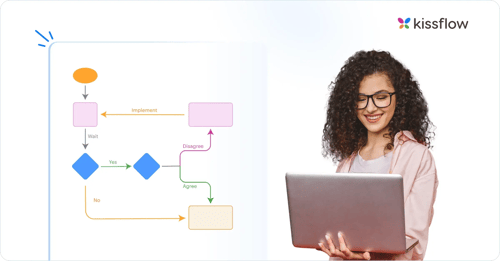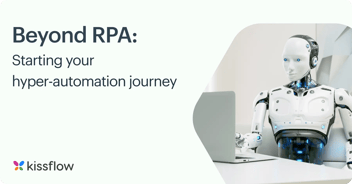
- >
- Workflow>
- What is Robotic Process Automation
What is Robotic Process Automation (RPA)? Complete Guide with Use Cases, Benefits & Smarter Alternatives
Robotic Process Automation (RPA) is often the first tool enterprises explore when automating repetitive business tasks. By simulating user actions like typing, clicking, or copying data, RPA bots automate manual work at the interface level. While useful for basic task automation, RPA has several limitations—especially when organizations aim to scale automation across departments or support more dynamic workflows.
In this guide, we’ll break down what RPA is, how it works, where it delivers value, and where it falls short. We’ll also show how Kissflow’s unified platform—combining workflow automation and low-code development—offers a more strategic, scalable path for enterprise IT leaders.
According to Gartner[1], 25% of all RPA deployments will include AI or machine learning components by 2025, accelerating the move toward hyperautomation in enterprise settings.
What is Robotic Process Automation?
Robotic Process Automation (RPA) is a technology that enables organizations to automate repetitive, rules-based tasks by using software bots that imitate human interactions with digital interfaces. Unlike backend automation methods that rely on APIs or direct database access, RPA works at the presentation layer—meaning it uses the same screens and interfaces that human employees do.
These bots are programmed to follow specific, structured workflows by performing actions such as clicking, typing, navigating between fields, reading from files, and submitting forms. Because they mimic how a person would manually interact with software, they can be deployed in environments with minimal system access or technical intervention.
The global RPA software market is projected to reach $13 billion by 2030[2], up from $5.7 billion in 2024, reflecting the rapid and widespread adoption of RPA across industries.
Here’s a practical example of how an RPA bot operates in an invoice processing scenario:
-
Accesses email: Opens an email containing an invoice attachment.
-
Reads file contents: Extracts data such as invoice number, vendor name, and amount from a PDF or Excel file.
-
Logs into enterprise software: Signs into an accounting or ERP system using predefined credentials.
-
Inputs data: Enters the extracted invoice details into the appropriate fields within the software.
-
Submits the transaction: Completes the process by submitting the form and optionally downloading a confirmation.
These steps are executed without requiring any modification to the existing software systems.
RPA is most effective when applied to processes that are:
-
Highly structured: The inputs, outputs, and decisions are consistent.
-
Repetitive: The same actions are performed frequently and predictably.
-
Rule-based: The logic is clear and doesn’t require judgment or exceptions.
Because of these characteristics, RPA is often used as a quick fix to reduce manual labor in legacy-heavy environments where traditional automation options are limited. However, it is important to note that while RPA excels at task-level automation, it is not designed to handle complex workflows, dynamic decisions, or collaborative processes.
How RPA works: Task automation at the UI level
RPA systems are typically set up using drag-and-drop tools, scripts, or recorders that capture user behavior. Once configured, bots perform tasks such as:
-
Reading and parsing emails
-
Extracting values from PDFs or Excel sheets
-
Typing into online forms
-
Clicking through drop-down menus
-
Logging into desktop or cloud-based applications
Because RPA doesn’t require changes to back-end systems, it is especially popular in environments with legacy software or disconnected tools that lack APIs.
Benefits of RPA
RPA adoption continues to grow because of the immediate, measurable value it brings—especially in task-heavy functions. Key benefits include:
1. Faster execution
RPA bots can process tasks at a much higher speed than humans because they don’t get distracted, tired, or multitask inefficiently. For example, a bot can extract data from hundreds of invoices and input them into a system in minutes—something that could take a human hours. This significantly boosts productivity and shortens process cycle times.
2. Higher accuracy
Human error is common in repetitive tasks—like data entry—leading to issues such as typos, skipped fields, or incorrect calculations. RPA bots, however, follow pre-programmed rules and logic, ensuring tasks are completed with high precision and consistency, which is especially valuable in compliance-heavy industries like finance and healthcare.
3. Always available
Unlike human workers, RPA bots don’t need sleep, breaks, or vacation. They can work 24/7, 365 days a year. This means critical processes can continue running after business hours or across different time zones, leading to increased operational efficiency and faster response times.
4. Lower operational cost
Although there’s an upfront cost to set up RPA, the long-term savings are substantial. Bots reduce the need for manual labor on repetitive tasks, freeing up human employees for more strategic, value-adding activities. This lowers overhead costs and improves return on investment over time.
5. Non-invasive integration
RPA tools work on the user interface layer of existing applications, mimicking the way a human interacts with software. This means there's no need to change, upgrade, or integrate deeply into legacy systems. Organizations can automate processes without disrupting current workflows or investing in costly infrastructure changes.
These advantages make RPA an effective short-term solution for many repetitive processes.
Companies adopting RPA report an average ROI of 30–200% within the first year[3], primarily due to reduced errors, faster processing, and lower operational costs. Additionally, over 92% of businesses observed improved compliance and 86% saw a productivity boost after implementing RPA.
RPA use cases by function
RPA is best suited for rule-based, repetitive tasks across departments. Here's how it brings value by function:
1. Finance & Accounting
Focus: Streamlining high-volume transactional processes for better speed, accuracy, and compliance.
-
Invoice data entry into ERPs
Extracts invoice details and enters them into ERP systems for faster processing. -
Payment reconciliations
Matches payments with invoices or bank data to ensure accurate financial records. -
Financial report generation
Gathers and compiles financial data into standard reports efficiently.
2. Human Resources
Focus: Simplifying routine HR operations to reduce administrative workload and improve employee experience.
-
Employee onboarding form completion
Fills out necessary forms using new hire data to speed up onboarding. -
Benefits eligibility checks
Validates employee eligibility for benefits by referencing predefined rules. -
Document generation
Produces HR documents like offer letters and contracts using templates.
3. IT Services
Focus: Managing routine IT support tasks to improve efficiency and minimize downtime.
-
Password reset workflows
Handles reset requests instantly without IT team involvement. -
User account provisioning
Creates or updates user access across systems based on roles. -
Log analysis and alerts
Scans logs for unusual activity and triggers alerts when needed.
4. Procurement
Focus: Enhancing procurement cycle efficiency by reducing manual intervention in supplier and order management.
-
Vendor data updates
Updates vendor details across internal systems to maintain accurate records. -
Purchase order creation
Generates POs based on inventory needs or approval triggers. -
Audit trail reporting
Tracks procurement activities to ensure process transparency and compliance.
5. Customer Service
Focus: Improving response time and service quality by handling repetitive support tasks.
-
Auto-responses to common queries
Sends quick, predefined replies to frequently asked customer questions. -
SLA tracking and escalation
Monitors service-level agreements and flags breaches for immediate attention. -
Complaint classification and routing
Categorizes incoming complaints and forwards them to the right department.
Each of these areas benefits from removing manual tasks while improving speed and consistency.
RPA limitations in enterprise automation
Despite its tactical value, RPA is not designed for strategic, long-term automation. Key drawbacks include:
-
High fragility: A small change in UI (e.g., a field name) can break a bot
-
No decision-making: RPA cannot handle exceptions or branch logic
-
No visibility: Lacks a holistic view of process performance
-
High maintenance: Bots require frequent reconfiguration
-
No collaboration: Tasks remain isolated, without integration into broader workflows
These issues make RPA hard to manage at scale—especially for CIOs and CDOs driving digital transformation.
RPA vs workflow automation vs low-code platforms
By 2026[4], over 65% of enterprise automation initiatives will combine RPA with workflow automation and low-ode tools, reflecting the rising demand for scalable, integrated business solutions.
To understand which tool is right for the job, it’s essential to compare RPA to two more scalable alternatives:
|
Aspect |
RPA |
Workflow Automation |
Low-Code Platform |
|
Primary focus |
Task-level automation |
End-to-end business process automation |
Building custom applications |
|
How it works |
UI interaction (no code/API) |
Form-based flow builders + API integrations |
Drag-and-drop app builders with logic and UI |
|
Best use case |
Invoice capture, login routines |
Leave approvals, procurement, service requests |
Internal portals, data dashboards, project tracking |
|
Scalability |
Limited due to bot fragility |
High—processes scale with business growth |
Very high—designed for enterprise-wide reuse |
|
Integration depth |
Low—screen scraping |
Moderate to high—supports APIs and native tools |
Highest—custom connectors and reusable components |
|
Governance & visibility |
Basic logs at bot level |
Centralized audit trail and SLA tracking |
Role-based access, data validation, and dashboards |
When does RPA make sense?
Use RPA when:
-
The process is highly repetitive and doesn't change often
-
There’s no API access or integration support
-
A quick fix is needed for manual work in legacy systems
-
Human input or logic branching is not required
RPA is tactical and efficient—but not built for long-term transformation.
According to McKinsey[5], up to 45% of current business activities could be automated using proven RPA and automation technologies, especially where processes are structured and repetitive.
Why workflow automation is better for cross-functional needs
Workflow automation platforms like Kissflow Workflow are built for process orchestration. They allow you to:
-
Design custom workflows using forms, steps, and conditions
-
Route tasks between people and departments
-
Apply business rules and role-based logic
-
Monitor SLAs and generate reports
-
Integrate with internal systems via APIs
This level of control and visibility is essential for digital operations, not just digital tasks.
Why low-code beats RPA for custom applications
Low-code tools like Kissflow Low-Code enable IT teams and business units to co-create applications that go beyond static workflows. You can:
-
Design data models, forms, and dashboards
-
Add conditional logic, validation, and user permissions
-
Connect with internal systems or third-party APIs
-
Roll out internal tools at a fraction of traditional dev time
When your goal is to build systems—not just bots—low-code is the clear choice.
Kissflow: The strategic alternative to RPA
Kissflow unifies workflow automation and low-code development to help organizations:
-
Automate approvals, requests, and escalations
-
Build reusable applications for HR, finance, procurement, and IT
-
Replace spreadsheets and manual forms with structured tools
-
Govern process automation across all departments
-
Integrate with your existing tech stack without UI scraping
Rather than deploying bots for every isolated task, Kissflow helps you build smarter systems that scale.
RPA isn’t the endgame - Here’s what’s next ?
RPA is useful for basic automation, but its task-level focus and high maintenance make it unsustainable as your organization grows. Workflow automation and low-code platforms, on the other hand, offer a foundation for scalable, cross-functional process management.
If you’re aiming for long-term digital maturity, RPA is just the first step. The real value comes from designing systems that evolve with your business—and Kissflow platform is built for that.
Start Automating Better, Not Just Faster
Frequently asked questions
1. What is Robotic Process Automation (RPA) in simple terms?
RPA is a technology that uses software bots to mimic human actions in digital systems, such as entering data, processing transactions, or responding to emails—helping businesses automate repetitive and rule-based tasks.
2. How is RPA different from traditional automation?
Unlike traditional automation, which relies on APIs and system-level integration, RPA works at the user interface level. It mimics human actions without changing existing systems, making it faster and easier to deploy.
3. What are the key benefits of using RPA?
RPA improves efficiency, reduces human error, lowers operational costs, enhances compliance, and allows employees to focus on higher-value work by automating mundane tasks.
4. What processes are best suited for RPA?
RPA is ideal for repetitive, rules-based, and high-volume tasks such as invoice processing, data entry, payroll, customer onboarding, and IT service desk operations.
5. Is RPA suitable for small and medium businesses (SMBs)?
Yes, modern RPA tools are scalable and cost-effective, making them accessible to SMBs. Cloud-based RPA solutions especially offer flexibility without the need for complex infrastructure.
Related Articles


.webp?width=352&name=making_the_best_of_business_process_automation_solutions%20(1).webp)








